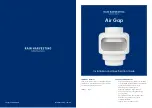4
VOICEMODELING EDIT PARAMETERS
VOICE MODELING (VM) STYLES AND
AMOUNTS
Here’s a good way to get started hearing all of
the Voice Modeling effects with your vocal.
• Go to factory preset 99 - we’ll use this preset
to do our experiments.
• Press the VM effect key so that it lights - the
effect is now active. Choose between
Inflection, Vibrato, Spectra, Breath, Growl
and Resonance.
• Double click that same key to enter the edit
parameters.
• Set the Amount to 50% - a midrange value.
• Use the ARROW DOWN key to scroll to the
next parameter - the styles. Styles are like
miniature factory presets for the VM
categories. Refer to the Preset, Style and
Application pamphlet for descriptions on the
effects applications, and the style functions.
INFLECTION EFFECTS
The inflection effect can alter the inflection of
your vocals in different ways. You can add
various types of "scooping" effects to the
onsets of a lead vocal for instance, but
inflection is also the place where you can find
the humanization tools that will help you give a
harmony line its own identity or create
extremely natural doubling effect. Inflection
provides tools such as portamento, pitch and
timing randomization (using our FlexTime
(TM)
algorithm) as well as up/down scoop models.
VIBRATO KEY EFFECTS
Vibrato is a pitch and amplitude effect that
singers often use in their delivery of a piece of
music. It is a combination of various
characteristics of the voice being repeatedly
altered in a oscillating fashion. Every singer's
vibrato is unique. The Vibrato Styles are based
on real vocalist's vibratos. We have analyzed a
large set of parameters from a voice database
and created various vibrato models. The
Vibrato setting names reflect the style of the
vocals from which they were extracted.
Experimentation is the key to finding a style
setting that best suits your application. You
might begin incorporating Vibrato into your
sound by setting the
VIB Amt
control to 50%.
This setting matches the depth level that we
analyzed in our modeling subjects. You can
then vary the effect from this middle range up or
down to suit your taste.
SPECTRAL KEY EFFECTS
The Spectral styles reflect the natural
equalization equivalent to the native control a
singer has over his or her own voice, and apply
this equalization to the VM voice. These styles
may be used in conjunction with the
resonances, or purely as additional tonal control
over the VM voice.
BREATH KEY EFFECTS
The Breath styles add breathiness to the vocal.
This varies from a whisper, all the way to a
rough, raspy sound, such as is found in hard
rock and ‘alternative’ rock music.
Some styles are sensitive to the dynamics of
the incoming vocal, meaning that they can be
‘played’ by varying the level of what is sung into
Voice One. This is also known as ‘self control’.
GROWL KEY EFFECTS
Growl in VoiceModeling mimics friction activity
between the larynx and epiglottis regions of the
vocal tract. This is a ‘character’ phenomenon
used in high energy rock, blues or old soul
music for example.
The Growl effect also models the changes in
the vocal tract shape that growling requires,
altering the vocal resonance characteristics.
Some styles are sensitive to the dynamics of
the incoming vocal, meaning that the effect can
be controlled by the volume of what is sung into
Voice One. This is also know as self-control.
RESONANCE KEY EFFECTS
Resonance styles allow you to take the
harmonic content that forms the identity of the
incoming voice and change the content’s
positioning to yield a new character to the
sound. Some styles change the voice to a
heavier, darker chest resonance, while others
lighten the sound to more of a head and throat
resonance. Some styles also change the voice
in a more complex way that depends on the
input voice.
Summary of Contents for VoiceOne
Page 1: ...VoiceOne Voice Pitch and Modeling Tool Quick Start Guide...
Page 2: ......


















